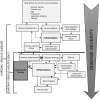Molecular Aspects of Wound Healing and the Rise of Venous Leg Ulceration: Omics Approaches to Enhance Knowledge and Aid Diagnostic Discovery
- PMID: 28798504
- PMCID: PMC5548371
Molecular Aspects of Wound Healing and the Rise of Venous Leg Ulceration: Omics Approaches to Enhance Knowledge and Aid Diagnostic Discovery
Abstract
Chronic wounds, in particular venous leg ulcers (VLU), represent a substantial burden for economies, healthcare systems and societies worldwide. This burden is exacerbated by the recalcitrant nature of these wounds, despite best practice, evidence-based care, which substantially reduces the quality of life of patients. Furthermore, co-morbidities such as diabetes and cardiovascular disease within ageing populations further contribute to the increasing prevalence in developed countries. This review provides an overview of the literature concerning the cellular and molecular mechanisms of wound healing and aspects where this process fails, resulting in a chronic wound. VLU may arise from chronic venous disease, which presents with many clinical manifestations and can lead to a highly complex disease state. Efforts to comprehend this state using various omics based approaches have delivered some insight into the underlying biology of chronic wounds and revealed markers of differentiation at the genomic, transcriptomic, proteomic and metabolomic levels. Furthermore, this review outlines the array of analytical tools and approaches that have been utilised for capturing multivariate data at each of these molecular levels. Future developments in spatiotemporal analysis of wounds along with the integration of multiple omics datasets may provide much needed information on the key molecules that drive wound chronicity. Such biomarkers have the potential to be developed into clinically relevant diagnostic tools to aid in personalised wound management.
Conflict of interest statement
Competing Interests: None declared.
Figures


References
-
- Mannello F, Ligi D, Canale M, Raffetto JD. Omics profiles in chronic venous ulcer wound fluid: innovative applications for translational medicine. Expert Rev Mol Diagn. 2014;14:737–62. - PubMed
-
- Jurd A. Expenditure on Healthcare in the UK, 1997–2010. Office for National Statistics. United Kingdom Crown copyright 2012.
-
- Posnett J, Franks PJ. The burden of chronic wounds in the UK. Nurs Times. 2008;104:44–5. - PubMed
-
- Markova A, Mostow EN. US skin disease assessment: ulcer and wound care. (ix) Dermatol Clin. 2012;30:107–11. ix. - PubMed
Publication types
LinkOut - more resources
Full Text Sources
Other Literature Sources
